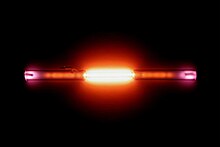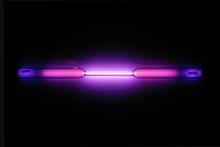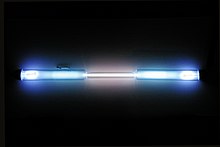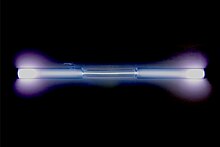नोबल ग्यास





नोबल ग्याँसहरू (ऐतिहासिक रूपमा निष्कृय ग्यासहरू, कहिलेकाहीँ एरोजेन्स भनेर चिनिन्छन् [१] ) पेरियोडिक तालिकाको समूह १८ का प्राकृतिक रूपमा पाइने सदस्यहरू हुन्: हिलियम (He), नियोन (Ne), आर्गन (Ar), क्रिप्टन (Ke)।, xenon (Xe), र radon (Rn)। साधारण अवस्थाहरूमा, यी तत्वहरू गन्धहीन, रंगहीन, धेरै कम रासायनिक प्रतिक्रियाशीलता र क्रायोजेनिक उम्लने बिन्दुहरू भएका मोनाटोमिक ग्यासहरू हुन्।
नोबल ग्याँसहरूको निष्कृयताले तिनीहरूलाई रासायनिक प्रतिकृया नचाहिने अवस्थामा उपयोगी बनाउँछ। उदाहरणका लागि, आर्गनलाई वेल्डिङमा सिल्डिङ ग्यास कवचको रूपमा र इन्यान्डेसेन्ट लाइट बल्बहरूमा फिलर ग्यासको रूपमा प्रयोग गरिन्छ। हिन्डनबर्ग दुर्घटनामा हाइड्रोजनको ज्वलनशीलताको कारणले गर्दा हुने जोखिमहरू स्पष्ट भएपछि, हाइड्रोजनलाई ब्लीम्प्स र बेलुनहरूमा हेलियमले प्रतिस्थापित गरियो। हेलियम र नियोनको पनि कम उम्लने तापक्रम को कारणले रेफ्रिजेरेन्टको रूपमा प्रयोग गरिन्छ। रेडन बाहेक नोबल ग्याँसहरूको औद्योगिक मात्रा, ग्यासहरूको तरलता र आंशिक आसवनको विधिहरू प्रयोग गरेर हावाबाट अलग गरेर प्राप्त गरिन्छ। हेलियम पनि प्राकृतिक ग्याँस को खनन प्रकृयाको एक उप-उत्पाद हो। रेडोन सामान्यतया विघटित रेडियम, थोरियम, वा यूरेनियम यौगिकहरूको रेडियोधर्मी क्षयबाट अलग गरिन्छ।
इतिहास
[सम्पादन गर्नुहोस्]नोबल ग्याँस जर्मन शब्द Edelgas बाट अनुवाद गरिएको हो , पहिलो पटक १९०० मा Hugo Erdmann द्वारा यी ग्यासहरूको प्रतिक्रियाको अत्यन्त कम स्तर संकेत गर्न प्रयोग गरिएको थियो [२] । यो नामले " नोबल धातुहरू " शब्दसँग समानता दिन्छ, जसको पनि प्रतिकृयाको स्तर अत्यन्त कम छ। नोबल ग्याँसलाई निष्क्रिय ग्यास पनि भनिन्छ, तर धेरै नोबल ग्याँस यौगिकहरू अहिले पहिचान भएकाले यो लेबललाई हटाइएको छ। [३] दुर्लभ ग्यासहरू अर्को शब्द हो जुन प्रयोग गरिएको थियो, [४] तर यो पनि गलत छ किनभने आर्गन रेडियोधर्मी पोटासियम-४० को क्षयको कारण बन्ने भएकाले पृथ्वीको वायुमण्डलमा पर्याप्त मात्रामा (०.९४% मात्रामा, द्रव्यमान हिसाबले १.३%) छ। [५]
भौतिक र आणविक गुणहरू
[सम्पादन गर्नुहोस्]| Property[६][७] | हिलियम | नियोन | आर्गन | क्रिप्टन | Xenon | Radon | Oganesson |
|---|---|---|---|---|---|---|---|
| घनत्व (g/dm<sup id="mw-g">3</sup>) | 0.1786 | 0.9002 | 1.7818 | 3.708 | 5.851 | 9.97 | 7200 (predicted)[८] |
| Boiling point (K) | 4.4 | 27.3 | 87.4 | 121.5 | 166.6 | 211.5 | 450±10 (predicted)[८] |
| Melting point (K) | – | 24.7 | 83.6 | 115.8 | 161.7 | 202.2 | 325±15 (predicted)[८] |
| Enthalpy of vaporization (kJ/mol) | 0.08 | 1.74 | 6.52 | 9.05 | 12.65 | 18.1 | – |
| Solubility in water at 20 °C (cm3/kg) | 8.61 | 10.5 | 33.6 | 59.4 | 108.1 | 230 | – |
| परमाणु क्रमाङ्क | 2 | 10 | 18 | 36 | 54 | 86 | 118 |
| Atomic radius (calculated) (pm) | 31 | 38 | 71 | 88 | 108 | 120 | – |
| Ionization energy (kJ/mol) | 2372 | 2080 | 1520 | 1351 | 1170 | 1037 | 839 (predicted)[९] |
| Electronegativity[१०] | 4.16 | 4.79 | 3.24 | 2.97 | 2.58 | 2.60 | 2.59[११] |
रासायनिक गुण
[सम्पादन गर्नुहोस्]
नोबल ग्याँसहरू मानक अवस्थामा रंगहीन, गन्धहीन, स्वादहीन र अज्वलनशील हुन्छन्। [१२] तिनीहरू एक पटक समूह लेबल गरिएको थियो आवधिक तालिकामा ० किनभने यो विश्वास गरिएको थियो कि तिनीहरूसँग शून्यको भ्यालेन्स छ, जसको अर्थ तिनीहरूको परमाणुहरू अन्य तत्वहरूसँग मिलाएर यौगिकहरू बनाउन सक्दैनन्। यद्यपि, पछि केही यौगिकहरू बनाउने कुरा पत्ता लाग्यो। [६]
इलेक्ट्रोन कन्फिगरेसन
[सम्पादन गर्नुहोस्]अन्य समूहहरू जस्तै, यस समुहका सदस्यहरूले यसको इलेक्ट्रोन कन्फिगरेसनमा ढाँचाहरू देखाउँछन्। बाहिरी अर्बिट इलेक्ट्रोन को संख्याले रासायनिक व्यवहार प्रवृतिहरू निम्त्याउँछ:
| Z | तत्व | इलेक्ट्रोन/ शेलको संख्या |
|---|---|---|
| २ | हेलियम | २ |
| १० | नियोन | २, ८ |
| १८ | आर्गन | २, ८, ८ |
| ३६ | क्रिप्टन | २, ८, १८, ८ |
| ५४ | जेनन | 2, 8, 18, 18, 8 |
| ८६ | रेडन | 2, 8, 18, 32, 18, 8 |
| ११८ | oganesson | 2, 8, 18, 32, 32, 18, 8 (पूर्वानुमान गरिएको) |
नोबल ग्याँसको पूर्ण भ्यालेन्स इलेक्ट्रोन शेल हुन्छ। भ्यालेन्स इलेक्ट्रोनहरू परमाणुको सबैभन्दा बाहिरी इलेक्ट्रोनहरू हुन् र सामान्यतया रासायनिक प्रतिकृयामा भाग लिने इलेक्ट्रोनहरू मात्र हुन्। पूर्ण भ्यालेन्स इलेक्ट्रोन शेल भएका परमाणुहरू अत्यन्तै स्थिर हुन्छन् र त्यसैले रासायनिक प्रतिकृयामा सहभागी हुँदैन र इलेक्ट्रोनहरू प्राप्त गर्ने वा गुमाउने प्रवृत्ति निकै कम हुन्छ। [१३] यद्यपि, राडोन जस्ता भारी नोबल ग्याँसहरू हेलियम जस्ता हल्का नोबल ग्याँसहरू भन्दा इलेक्ट्रोम्याग्नेटिक बल कम हुन्छ, यसले भारी नोबल ग्याँसहरूमा बाहिरी इलेक्ट्रोन हटाउन सजिलो हुन्छ।
प्रयोगहरू
[सम्पादन गर्नुहोस्]
नोबल ग्याँसको उम्लने र पग्लने बिन्दु धेरै कम हुन्छ, त्यसकारण तिनीहरू क्रायोजेनिक रेफ्रिजेरेन्टको रूपमा उपयोगी हुन्छन्। [१४] विशेष गरी, तरल हीलियम, जुन ४.२ के (−२६८.९५ °से; −४५२.११ °फे) मा उम्लन्छ, सुपरकन्डक्टिङ चुम्बकहरूका लागि प्रयोग गरिन्छ, जुन आणविक चुम्बकीय अनुनाद इमेजिङ र आणविक चुम्बकीय अनुनादमा आवश्यक हुन्छ। [१५] तरल नियोन पनि क्रायोजेनिक्समा प्रयोग हुन्छ, यद्यपि यो तरल हीलियम जत्तिकै कम तापक्रममा पुग्दैन, तैपनी यसमा ।तरल हीलियम भन्दा ४० गुणा बढी र तरल हाइड्रोजन भन्दा तीन गुणा बढी फ्रिज क्षमता हुन्छ। [१६]
Noble gases are commonly used in lighting because of their lack of chemical reactivity. Argon, mixed with nitrogen, is used as a filler gas for incandescent light bulbs.[१६] Krypton is used in high-performance light bulbs, which have higher color temperatures and greater efficiency, because it reduces the rate of evaporation of the filament more than argon; halogen lamps, in particular, use krypton mixed with small amounts of compounds of iodine or bromine.[१६] The noble gases glow in distinctive colors when used inside gas-discharge lamps, such as "neon lights". These lights are called after neon but often contain other gases and phosphors, which add various hues to the orange-red color of neon. Xenon is commonly used in xenon arc lamps, which, due to their nearly continuous spectrum that resembles daylight, find application in film projectors and as automobile headlamps.[१६]
सन्दर्भ सामग्रीहरू
[सम्पादन गर्नुहोस्]- ↑ Bauzá, Antonio; Frontera, Antonio (२०१५), "Aerogen Bonding Interaction: A New Supramolecular Force?", Angewandte Chemie International Edition 54 (25): 7340–3, डिओआई:10.1002/anie.201502571, पिएमआइडी 25950423।
- ↑ Renouf, Edward (१९०१), "Noble gases", Science 13 (320): 268–270, डिओआई:10.1126/science.13.320.268, बिबकोड:1901Sci....13..268R।
- ↑ Ozima 2002, p. 30
- ↑ Ozima 2002, p. 4
- ↑ "argon"।
- ↑ ६.० ६.१ "Noble Gas"।
- ↑ Greenwood 1997, p. 891
- ↑ ८.० ८.१ ८.२ Smits, Odile; Mewes, Jan-Michael; Jerabek, Paul; Schwerdtfeger, Peter (२०२०), "Oganesson: A Noble Gas Element That Is Neither Noble Nor a Gas", Angew. Chem. Int. Ed. 59 (52): 23636–23640, डिओआई:10.1002/anie.202011976, पिएमआइडी 32959952, पिएमसी 7814676।
- ↑ Winter, Mark (२०२०), "Organesson: Properties of Free Atoms", WebElements: THE periodic table on the WWW, अन्तिम पहुँच ३० डिसेम्बर २०२०।
- ↑ Allen, Leland C. (१९८९), "Electronegativity is the average one-electron energy of the valence-shell electrons in ground-state free atoms", Journal of the American Chemical Society 111 (25): 9003–9014, डिओआई:10.1021/ja00207a003।
- ↑ Tantardini, Christian; Oganov, Artem R. (२०२१), "Thermochemical Electronegativities of the Elements", Nature Communications 12 (1): 2087–2095, डिओआई:10.1038/s41467-021-22429-0, पिएमआइडी 33828104, पिएमसी 8027013, बिबकोड:2021NatCo..12.2087T।
- ↑ Ullmann's Encyclopedia of Industrial Chemistry – Volume 23, पृ: २१७।
- ↑ Ozima 2002, p. 35
- ↑ "Neon"।
- ↑ Zhang, C. J.; Zhou, X. T.; Yang, L. (१९९२), "Demountable coaxial gas-cooled current leads for MRI superconducting magnets", IEEE Transactions on Magnetics (IEEE) 28 (1): 957–959, डिओआई:10.1109/20.120038, बिबकोड:1992ITM....28..957Z।
- ↑ १६.० १६.१ १६.२ १६.३ Ullmann's Encyclopedia of Industrial Chemistry। उद्दरण त्रुटी: Invalid
<ref>tag; name "ullmann" defined multiple times with different content
|
हाइड्रोजन • हेलियम • लिथियम • बेरिलियम • बोरोन • कार्बन • नाइट्रोजन • अक्सिजन • फ्लोरिन • नियोन • सोडियम • म्याग्नेसियम • एल्युमिनियम • सिलिकन • फोस्फरस • सल्फर • क्लोरिन • आर्गन • पोटासियम • क्याल्सियम • स्क्यान्डियम • टाइटानियम • भेनेडियम • क्रोमियम • म्याङ्गनिज • फलाम • कोबल्ट • निकेल • तामा • जस्ता • ग्यालियम • जर्मेनियम • आर्सेनिक • सेलेनियम • ब्रोमिन • क्रिप्टन • रुबिडियम • स्ट्रन्सियम • इट्रियम • जर्कोनियम • नियोबियम • मलिब्डेनम • टेक्निसियम • रुथेनियम • रोडियम • प्यालेडियम • चाँदी • क्याड्मियम • इन्डियम • राङ • एन्टिमोनी • टेलुरियम • आयोडिन • जेनन • सिजियम • बेरियम • ल्यान्थनम • सिरियम • प्रेजियोडिमियम • नियोडिमियम • प्रोमिथियम • समेरियम • युरोपियम • ग्याडोलिनियम • टर्बियम • डिस्प्रोजियम • होल्मियम • अर्बियम • थुलियम • इटर्बियम • लुटिशियम • ह्याफ्नियम • ट्यान्टलम • टङ्स्टेन • रिनियम • अज्मियम • इरिडियम • प्लेटिनम • सुन • पारो • थ्यालियम • सिसा • बिस्मथ • पलोनियम • एस्टटिन • रेडन • फ्रान्सियम • रेडियम • एक्टिनियम • थोरियम • प्रोट्याक्टिनियम • युरेनियम • नेप्ट्युनियम • प्लुटोनियम • एमरिशियम • क्युरियम • बर्क्लियम • क्यालिफोर्नियम • आइन्स्टाइनियम • फर्मियम • मेन्देलिभियम • नोबेलियम • लरेन्सियम • रदर्फोर्डियम • दुब्नियम • सिबोर्गियम • बोरियम • ह्यासियम • माइट्नेरियम • डार्मश्टाटियम • रेन्टगेनियम • उनुन्बियम • उनुन्ट्रियम • उनुन्क्वाडियम • उनुन्पेन्टियम • उनुन्हेक्सियम • उनुन्सेप्टियम • उनुनक्टियम |
| पेरियोडिक तालिका | ||||||||||||||||||||||||||||||||||||||||||
|---|---|---|---|---|---|---|---|---|---|---|---|---|---|---|---|---|---|---|---|---|---|---|---|---|---|---|---|---|---|---|---|---|---|---|---|---|---|---|---|---|---|---|
| H | He | |||||||||||||||||||||||||||||||||||||||||
| Li | Be | B | C | N | O | F | Ne | |||||||||||||||||||||||||||||||||||
| Na | Mg | Al | Si | P | S | Cl | Ar | |||||||||||||||||||||||||||||||||||
| K | Ca | Sc | Ti | V | Cr | Mn | Fe | Co | Ni | Cu | Zn | Ga | Ge | As | Se | Br | Kr | |||||||||||||||||||||||||
| Rb | Sr | Y | Zr | Nb | Mo | Tc | Ru | Rh | Pd | Ag | Cd | In | Sn | Sb | Te | I | Xe | |||||||||||||||||||||||||
| Cs | Ba | La | Ce | Pr | Nd | Pm | Sm | Eu | Gd | Tb | Dy | Ho | Er | Tm | Yb | Lu | Hf | Ta | W | Re | Os | Ir | Pt | Au | Hg | Tl | Pb | Bi | Po | At | Rn | |||||||||||
| Fr | Ra | Ac | Th | Pa | U | Np | Pu | Am | Cm | Bk | Cf | Es | Fm | Md | No | Lr | Rf | Db | Sg | Bh | Hs | Mt | Ds | Rg | Cn | Uut | Uuq | Uup | Uuh | Uus | Uuo | |||||||||||
| ||||||||||||||||||||||||||||||||||||||||||
| ||||||||||||||||||||||||||||||||||||||||||
Text is available under the CC BY-SA 4.0 license; additional terms may apply.
Images, videos and audio are available under their respective licenses.
